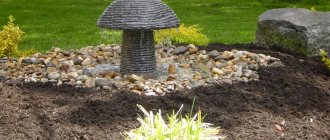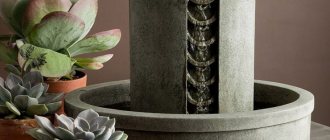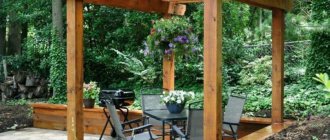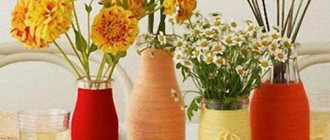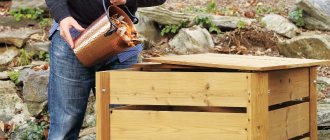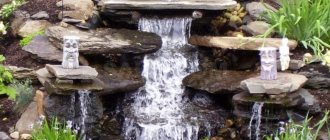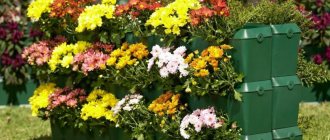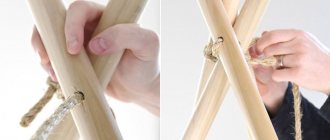Remember those times when people went to city squares or parks to admire the beauty of the fountain? Today everything has changed and you have a real opportunity to equip a structure that is magnificent in all respects on your suburban site, and you do not need to hire a team of expensive specialists to carry out installation work. This is only at first glance, it seems that arranging fountains in a dacha with your own hands is difficult and beyond your capabilities, but once you delve deeper into the essence of the task, you will understand that everything is not as expensive and scary as you thought.
fountains are a great addition to landscape design
Don’t rush to grab a shovel and run to dig a pit. In the construction of fountains, the preparatory period is important, including:
- Creation of a design project.
- Selecting the shape of the future fountain.
- Selection and purchase of materials and components.
Knowing what these structures can be like and what their main differences are will help you do everything right.
Classification of garden fountains
a small fountain is installed in small areas
Creating a garden highlight should start with choosing its type. There are an incredible variety of such architectural delights. You will decide which composition will appear at your dacha, relying on your taste and taking into account the nuances of the landscape. The most acceptable fountain designs for arranging them at the dacha with your own hands are:
- Classic.
- Geyser.
- Avant-garde.
- Mounted.
- Flowing.
fountain decorated with natural stone
The former are characterized by the presence of sculpture in the composition. Secondly, the water jets are saturated with air, which causes the flowing streams to bubble and foam. Thirdly, water smoothly flows down a transparent glass wall, and the stream seems to float in the air. In mounted versions, water flows like a film, creating wide stripes and gentle waterfalls. In the last category - fountains, springs, streams, cascades, in general, all types with water moving into the distance.
Based on the method of construction, fountains are divided into:
- Submersible.
- Stationary.
example of a submersible fountain
Submersible structures
If you look at the degree of complexity, then submersible fountains are the easiest to build in the country. Their main feature is that the jet will shoot directly from the water. In such structures there is no need to install additional technical equipment. The main point here will be the choice of the shape of the nozzle that supplies and forms the jet, which is connected to the pump hose without any extra wisdom. The level of water rising into the air and the number of jets will be determined by the power of the pump. We will talk about this part of the home fountain separately. Experimentally, using several nozzles, you can create different options for the play of flows, thus, the pond will harmoniously fit into the design of the site, no matter how intricate it may be.
fountain sculptures
Stationary structures
Such fountains are the prerogative of parks and squares.
The concept of stationary is associated in them with the presence of global decorative elements that play the role of a water supply source. When arranging fountains in your dacha with your own hands, it is not at all necessary to spend money on purchasing any sculptural compositions or statues . Any items used in landscape decoration can be entered.
The fountain's container is made of a bowl
To design such a fountain, you will have to work hard, but it will look like a masterpiece. It will produce a special effect if the composition fits perfectly into the stylistic design of a country estate.
Combined designs
They should be considered as an alternative option. In such fountains, the gushing jets do not just fall back into the water, but end up on stone slides, along which they flow in streams into the main reservoir. Bringing such an idea to life won’t be technically difficult; there will be more hassle with aesthetic harmonization. A waterfall and a fountain should not exist separately, they need to be made one.
classic fountain in the garden
The proposals considered are not a complete list of how fountains can be made in the country. You have the right to fantasize and create them at your own discretion. You can arrange a whole group of fountains, combining them compositionally into an ensemble that will become a key element of the landscape of your site.
Basic principles of creating a flower garden
When designing a picturesque flowerbed, you should focus on a number of rules for its rational design and understand the terminology. There are mainly two groups:
- Flower beds that have a regular shape with strict geometric parameters;
- Varieties of flower beds of any, sometimes the most unexpected configuration.
Fountain dimensions
“At first glance, it seems that arranging fountains in a dacha with your own hands is difficult and beyond your capabilities, but once you delve deeper into the essence of the task, you will understand that everything is not as expensive and scary as you thought”
Before building a pond, you will decide on its appearance, style and, of course, dimensions. The size of the bowl should be commensurate with the area of the yard. Agree, a grandiose structure will look, to put it mildly, ridiculous in a small area. For such courtyards, it is preferable to equip small stone fountains, the water in which does not rise to the sky, but gently flows down the uneven slopes of the hill with a sweet murmur. Compositions in the spirit of country, stylized as a windmill or fountains in which water flows from a tilted jug, will be good.
the base is made in the form of an amphora
To build mini fountains in the country, it is more rational to purchase ready-made bowls. Today they are made from composite or durable plastic and are offered in a variety of shapes and colors.
Experts recommend giving priority to composite models. They are more practical and are not subject to temperature deformation, so you do not have to seasonally install and dismantle the bowl.
stone fountain
If you want to decorate a pond at your dacha with fountains, then you will have to remove the reservoir yourself. This way you can give the container the intended shape, rather than adapting to the proposed ready-made standards for synthetic bowls.
Preparing a suitable container
When deciding to create a fountain with your own hands in the garden, it is important to wisely choose or make your own container for a hydraulic installation.
As a fountain bowl, you can use ready-made plastic containers of various shapes, which allow you to ensure reliable waterproofing
To create larger fountains, it is necessary to dig a pit, at the bottom of which a foundation for the future structure will be installed. The bottom of the dug pit for the fountain is covered with a layer of sand, the side walls are reinforced with bricks. After this, the inner surface of the tank can be covered with plastic film, which does not allow water to pass through. Sealing of surface seams can be achieved by treating them with frost-resistant silicone.
An important point: the depth of the foundation must be below the soil level. This placement will eliminate the possibility of soil being washed away around the fountain bowl.
An emergency drain can be provided not far from the edge of the surface, the presence of which will prevent the water from rising above the required level.
Craftsmen, when creating a fountain with their own hands at the dacha, use any waste materials: natural stones, river pebbles, car tires, glass products, ceramic parts
The main requirement for the material is high strength characteristics and the ability to withstand temperature changes.
The finished bowl can be filled with water.
Looking for a place
“The construction of fountains at the dacha with your own hands can be carried out in any style that appeals to the household”
Arranging a fountain in the yard is a successful solution in many respects. This is a great way to humidify the hot summer air, a great opportunity to normalize the nervous system. You can have a fun party near it. The fountain bowl can serve as a reservoir for watering. In general, beautiful, practical, useful. The construction of fountains at the dacha with your own hands can be carried out in any style that appeals to the household. Regardless of the stylistic decision of the composition, it is guaranteed to turn out to be the brightest touch of the surrounding space. The mesmerizing shimmer of water droplets filled with rainbow colors and the gentle sun will not allow anyone to remain indifferent.
the fountain is decorated with a single sculptural composition
When looking for a site for the construction of a hydraulic engineering facility, pay special attention to the presence of a slope of the ground and its degree. It is best to place the installation in a low area. This will make it possible to saturate the surrounding air with moisture as much as possible and at the same time replenish the volume of groundwater. There is no need to allocate for this:
- Places that are too open, as the abundance of sun will cause water to bloom.
- Areas under the canopy of large trees. Their roots are powerful and, sensing moisture, they easily deform the bowl of the reservoir, breaking through the waterproofing layer. Also, the tank will constantly be clogged with fallen leaves and fruits. This can cause blockage of the drains with all the literally ensuing consequences.
- A place near the house. The walls of a building are unlikely to like excess moisture.
Look for an area that can be easily seen from different angles. This will be an ideal place to set up a fountain.
organization of fountain lighting
Draining
The principle of operation of the fountain is as follows: you pour water at once and then it circulates in a closed cycle.
During the hot months, you need to add the part of the water that has evaporated. However, some customers connect drainage pipes directly to the concrete pad in Moscow. In this case, we make an additional hole in the bottom of the bowl and bring pipes there. It looks like this:
In the finale, this fountain looked like this (the customer’s wife asked to change the color of the fountain):
Initially there were pebbles around the edges, but since the children were constantly throwing these pebbles into the pool, the customer decided to cover it with soil and plants. On the right in the video you can see how the box with wires is hidden in the lawn. The pipes are also hidden.
Construction stages
The construction of fountains at the dacha with your own hands will have to be carried out in stages. The first step is to prepare the tank for water, then install the pump and, if necessary, additional equipment. Everything will end with decorative work.
Stage I
The site has been chosen, and it’s time to pick up a shovel. A pit of a given size is dug using pre-applied markings. It is very important to make its depth with a margin of 50 centimeters. This space will be needed for laying a drainage cushion. The bottom and edges of the resulting pit are compacted with the clap of a shovel. Then you will again be faced with a choice of what to make the fountain bowl from. The material for its creation can be concrete. A flexible formwork is placed on the drainage pad and a liquid solution is poured into it.
fountain with several rectangular containers
You can use a lightweight version. The bowl in it is thick polyethylene. The pit is lightly sprinkled with small pebbles mixed with sand. Polyethylene is placed on top of such drainage. It is fixed along the bottom and “shores” with stones. The finished bowl is filled with water to check the tightness. It is important to use exclusively river stones in a lightweight bowl. They do not have sharp corners that can damage the film.
Stage II
The next step in creating fountains in the country will be the installation and launch of their “heart” - the pumping system. To ensure a continuous flow of water, a powerful device will be required, so the success of the entire event depends on the correct choice.
11
The principle of operation of the system is as follows: water is released under pressure through a nozzle, collecting in a bowl. From there it goes into the drain hole and returns to the pipeline, where it again undergoes double cleaning. Clean water enters the pump. For the drainage system in fountains, it is better to use sixteen-millimeter plastic pipes. They are durable and have excellent performance characteristics. The pipeline sections are connected by soldering.
The pump is traditionally placed at the bottom of the tank. This part does not need fixing, because it has a decent weight. A spray nozzle is attached to the outlet hose. This element will have to be tightly fixed in a given position. It would be good if the kit you purchased included a special mounting spacer for the sprayer. If it is missing, the hose will need to be clamped with stones. The main thing is to do it in such a way as not to squeeze it anywhere. The water flow must be free, otherwise the pump will burn out.
small fountain made in oriental style
As for the power of the supply system, its indicator will be directly proportional to the volume of the reservoir bowl. The receiver will help maintain the pressure in the water entering the nozzle. With its appearance, the supply system will work smoothly. The same design principle is ideal for cascade structures.
The final touch before starting decorative work will be checking and adjusting the pump.
fountain surrounded by flowers
Stage III
The original design of fountains at the dacha with your own hands is also entirely within your competence . This can be done in different ways, the main thing is to correlate your ideas with the available capabilities. What will help a fountain become a key point in the landscape?
- Beautiful aquatic plants and moisture-loving flowers.
- Decorative sculpture.
- Pergola entwined with greenery.
- Alcove.
- Comfortable benches.
- Backlight.
- Sandy paths leading to the fountain.
fountain. decorated with rough natural stone
There are no restrictions. Polystone structures will not need additional decor. Such a bowl is initially laconic in its appearance and is completely undemanding in maintenance.
When trying to give your dacha fountains a natural look, use the following recommendations:
- The stones in the pond must be of the same origin. In nature, you will not find examples of piles of multi-colored and multi-format monoliths.
- Plants planted around the fountain should not suffer from water jets hitting them.
- If you plan to place fish in the resulting pond, then choose varieties that will calmly respond to the sound of falling water. Flocks rushing around in panic will not cause relaxation.
spring fountain
Care Tips
Fountain structures in country and garden plots require certain maintenance measures. It is optimal to install such hydraulic structures in an open area, without close proximity to trees or shrubs, the falling leaves of which can quickly clog the water surface. Over time, as a result of the decomposition of leaves, the water in the bowl acquires a cloudy appearance, rots and begins to emit an unpleasant odor.
To avoid water contamination, it is necessary to use special filter systems. Large plant debris can be removed with a long-handled net. Also, to purify water in fountain structures, some types of algae are used, which are planted directly into the bowl. Such vegetation not only allows for water purification, but also creates a very picturesque natural composition, especially if the algae is supplemented with flowering crops or fish.
We light fountains in the country house with our own hands
Exotic plants, colored fish, unusual stones - all this is great, but the decor of the fountain will never be complete if you don’t take care of its lighting. It should be as cheerful and colorful as the sun. Lighting fixtures must be designed to withstand constant exposure to a humid environment. Solar-powered lights can be installed along the perimeter of the zone, and bottom or floating lights can be lowered into the tank itself. Such a lighting decor will look incredibly impressive.
11
LED strips are suitable for design purposes. They are good for emphasizing the contours of the fountain bowl. Small light bulbs provide unobtrusive light of low intensity, but it is enough to see the beauty of the structure.
Conclusion
As you can see, building beautiful fountains at your dacha with your own hands is quite a feasible task. So the eyes were afraid in vain. Having the desire to become the owner of such a magnificent element of landscape decor works wonders. And beauty, in this case, is not at all synonymous with high cost, so let’s get to it!
Installation by crane
Ideally, the crane (based on Gazelle or Lawn) should drive directly to the installation site in Moscow. It will not pass on the ground, it will fall through or dig up the entire lawn. (The same manipulator on which the fountain will come from Moscow to you). It looks like this:
If this is not possible, then he unloads near the fence. Then we order a large Ivanovets crane (27-32 tons) and with its long boom it delivers the products to the installation site. As a rule, the customer pays the cost of Ivanovets separately:
Photo gallery - do-it-yourself fountains in the country:
Varieties of flower bed shapes
- Geometric. They have a clear outline and correct configuration.
- Natural. They represent a free outline, imitating the free arrangement of plants.
- Elevated. They are created inside high fences, giving an unusual decorative design.
- Monochrome. In such flower beds one variety of plants is grown.
- Multi-tiered. Special structures with several levels are pre-installed. Flowers and green ornamental plants are planted on them. Usually compact varieties are selected.
- Symmetrical. They bring orderliness to the landscape.
- Combined. There are countless combination variations in color, shape, and height.
Which plants to choose
In the process of creating flower beds that organically fit into the overall style of the landscape, it is necessary to be guided by several principles.
Rules for arranging flower beds
- Plants are selected in a contrasting or harmonious combination of similar colors, taking into account not only the color of the petals, but also the shape and size of the plant.
- It is not recommended to create excessive spice. Usually no more than four varieties are placed in one flowerbed.
- The height of the selected flower crops is taken into account, placing low-growing varieties at the forefront.
- The highest aerobatics of landscape art is considered to be the provision of a continuous change in the color background, thanks to the planting of varieties with different periods of bud formation.
- Giving preference to perennials, they turn to zoned varieties that can withstand the winter seasons without damage.
Plants such as clematis and peonies can grow without replanting for several decades, delighting with abundant flowering.
On a note! The advantages of perennial flowers also include easy care and low financial costs, since there is no need to purchase new seedlings every year.
Among modern trends, several color options for flower beds attract attention:
- Monochrome. Involves the selection of shades of different saturations of the same color. This group also includes plants with decorative foliage, the variety of which varies from silver-green, ant, malachite, lemon to pearl tones.
- Green and white combinations. To create such a fresh sound, primrose, peonies with white inflorescences, and hydrangea are planted. Mock orange and spirea add charm to the site.
- Green-pink version. Chrysanthemums, clematis, charming roses, and astilbe create unusually delicate and imaginative tints in this range. You can plant decorative barberry and bergenia.
- Monoformality. It involves placing varieties that have a single shape in one flower bed. An interesting option is the round crown. For example, blue fescue, standard roses, and large-leaved hydrangea are planted. The spherical thuja adds charm and amazing grace.
- Contrast. To solve such a problem, which involves an unusual, very bright sound, flowers are planted that have, for example, yellow and purple colors. Burgundy and blue buds create a striking contrast.
A fashionable option remains the blue-yellow combination, for which irises of different varieties, viola, delphinium, and daylily are suitable.
Monoclumba - stylish and simple
Traditional lawns can easily be enlivened with a monoflower - a small flower meadow on a green, clipped carpet. In the center of the lawn, the soil is removed along with the grass, the area is fenced off with a flexible border, and the interior space is filled with fertile soil mixture.
In the resulting “window” any flowers suitable for the country landscape are planted.
If bulbous plants (tulips, daffodils) are used, after they have finished flowering, bright annuals can be planted in the monoflower bed: petunia, viola, tagetes, zinnia, celosia and others.
Majestic roses and graceful cannas look very beautiful on the green lawn.
Plants with variegated (variegated) foliage will help create an unusual composition, for example, creeping species of euonymus fortunena, variegated brunnera, some types of hosta, ivy-leaved budra.
At your dacha you can create just one small flower bed or several types of flower beds. In any case, they will decorate the area, uplifting the mood and conducive to relaxation.
How it works
At first glance, it’s not difficult to build the simplest artificial stream, waterfall or fountain. The design includes the following elements:
- a drainage bowl, which is a small artificial reservoir;
- a decorative part consisting of beautifully laid stones, a sculptural composition, a cascade of several bowls, etc.;
- nozzles that give the water stream the desired shape (only in jet fountains);
- connecting hoses supplying water from the bowl to the nozzles;
- a pump, thanks to which water is set in motion and flows from the bowl to the nozzles;
- additional devices - filters, water level sensors, jet illumination.
The pump forces water through hoses into the nozzles, from where it sprays in the form of beautiful jets, after which it flows into the drainage bowl and again enters the working chamber of the pump. Sizes and design depend solely on your wishes and capabilities.
Nozzle selection
If you decide to build a jet fountain, then its most important element is the nozzle, which gives the flowing stream of water a certain shape. The most popular types of nozzles are:
- bell. Water flows into the slot around the circumference of the nozzle, forming a solid dome in the form of a hemisphere or bell. This is one of the most beautiful and spectacular small fountains for a summer cottage;
- geyser. Jets of water are supplied under powerful pressure and are thrown vertically upward through several holes in the end part, simultaneously being saturated with air bubbles. The height of the jets is adjusted by changing the water pressure;
- crown. The jets are ejected through holes located around the circumference, with a slight slope from the center, forming a spectacular crown.
When assembling the fountain, several nozzles can be used, which are placed in a certain sequence or at an angle. The jets form a spectacular picture, arranged in tiers or lattice.
Technical solutions for the bowl
There are many options for a catch basin. From a technical point of view, there are three main ways to construct it:
- concreting. The most expensive, labor-intensive, but also the most durable option. They dig a pit of the required size, lay a waterproofing layer, fill it with concrete, and line it with tiles or natural stone;
- waterproofing film. This method is usually used for the manufacture of small structures. They dig a hole in the ground the size of the future bowl, line the walls with a special film in several layers, then mask the film with pebbles or stone fragments. It turns out to be a small picturesque pond;
- plastic container. Select a ready-made reservoir for an artificial pond made of plastic, dig it into the ground, and decorate the edges with stones.
For summer cottages, the last two options are most often chosen. Such fountains are accessible to almost everyone and are not particularly difficult to manufacture. It should be noted that the diameter of the bowl should be approximately one and a half times the height of the jets so that all the water returns back to the tank for reuse.
Decorative garden pond 1400l 244x144x55cm
